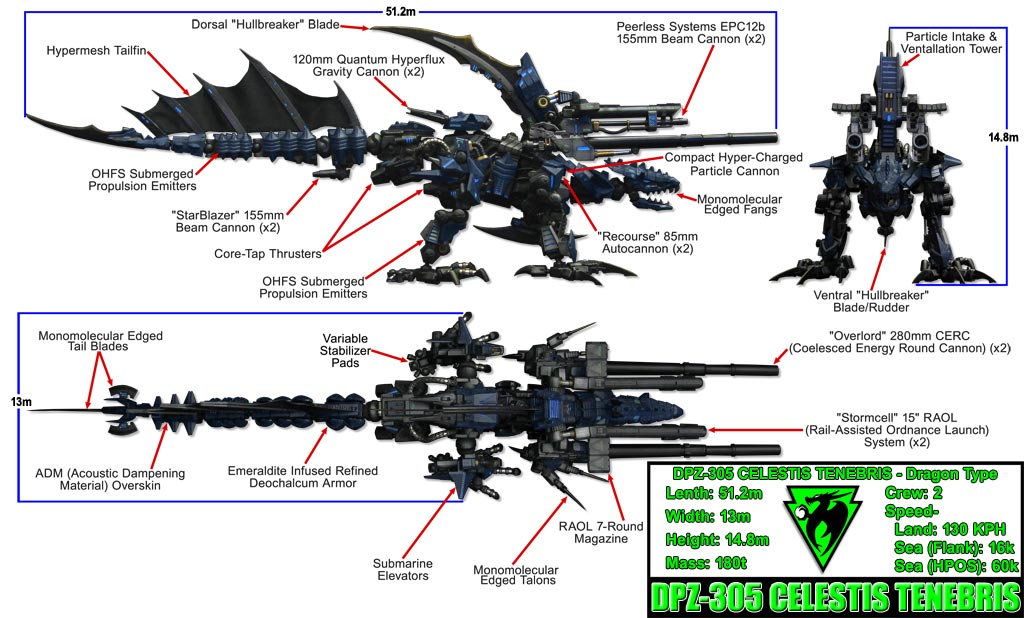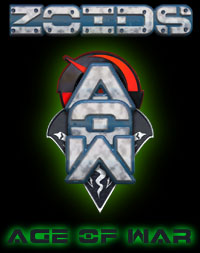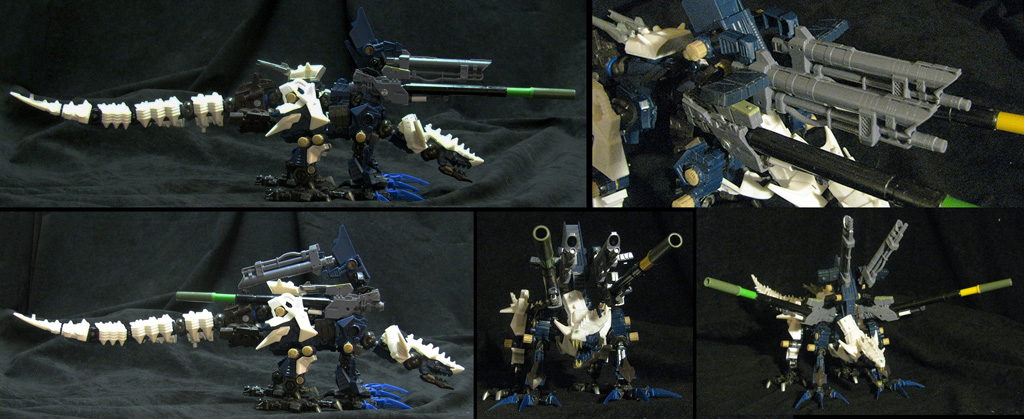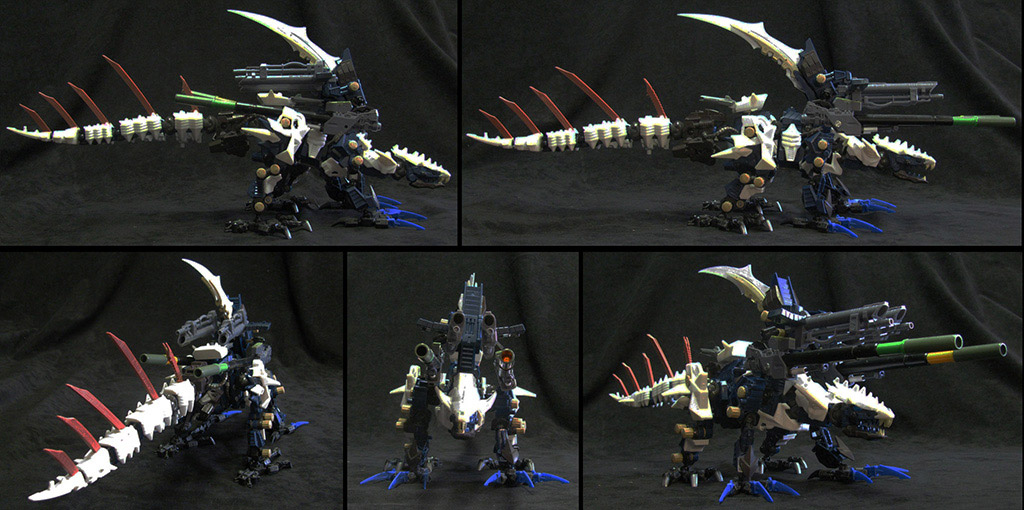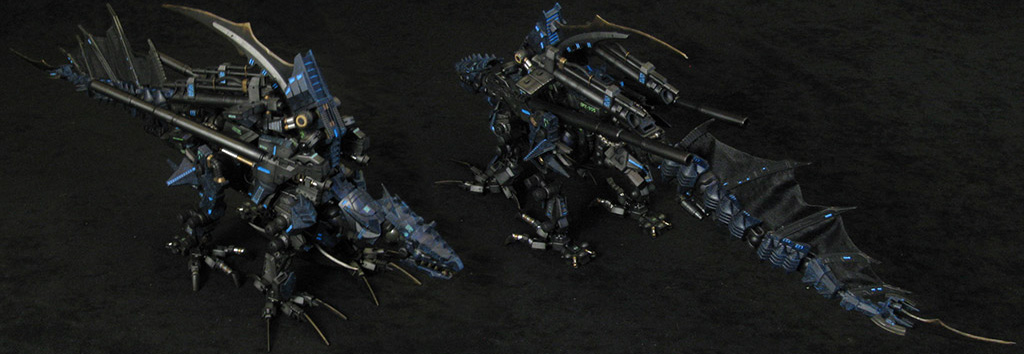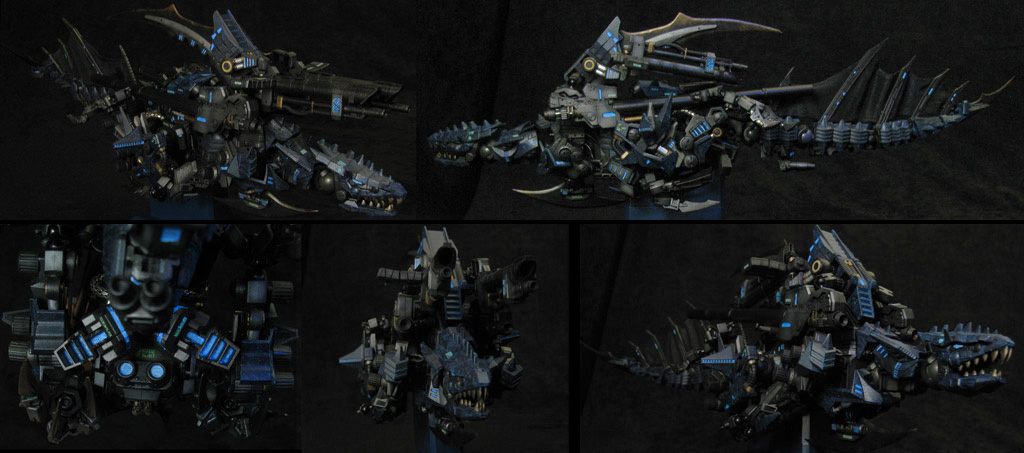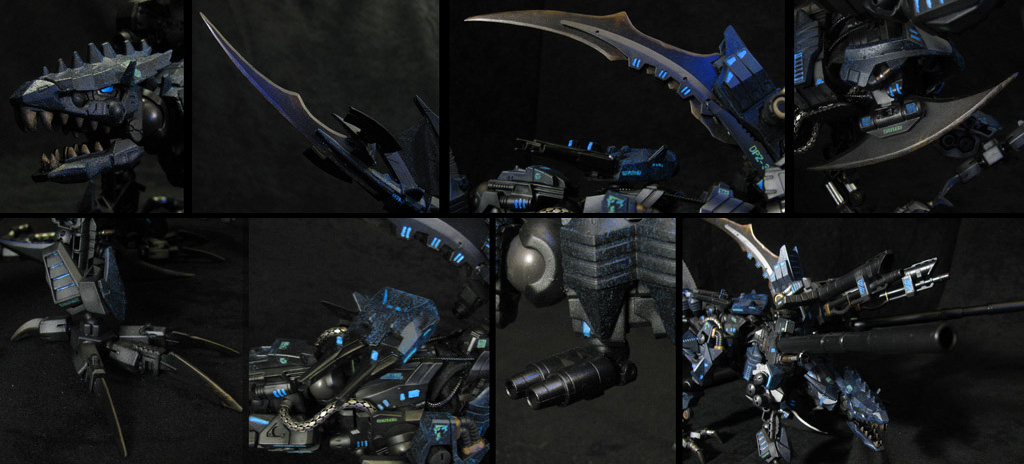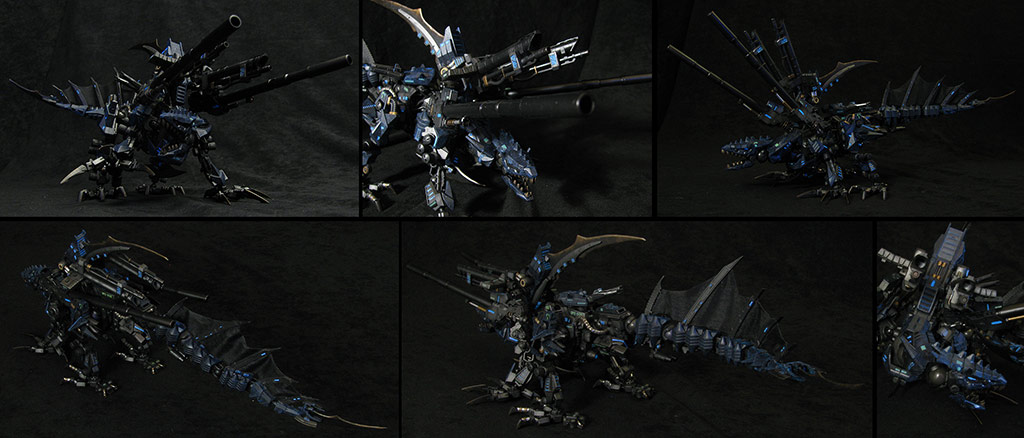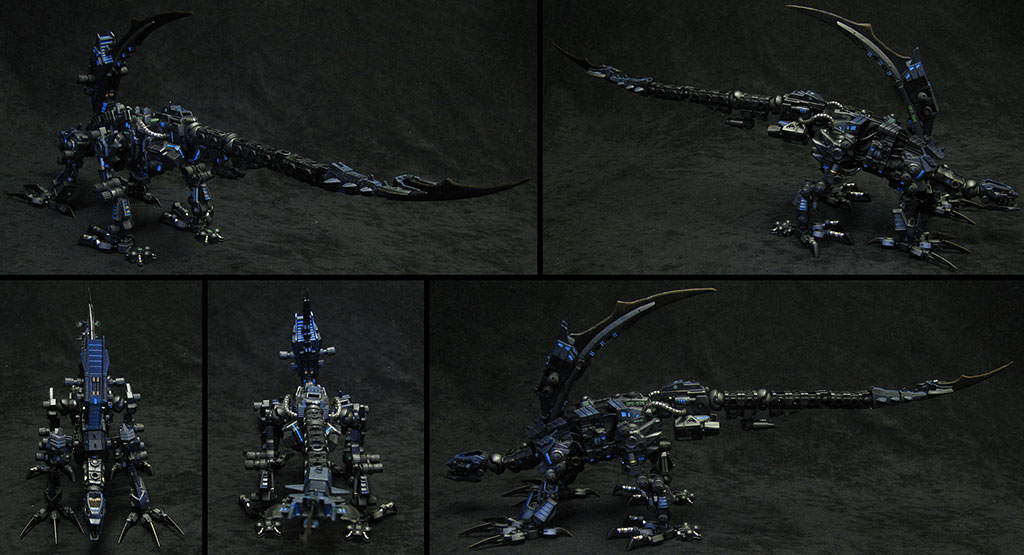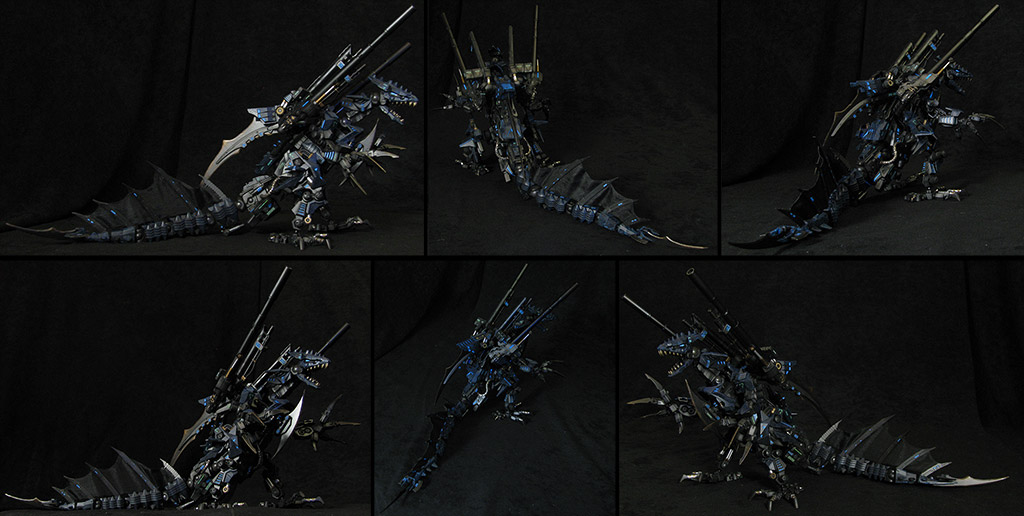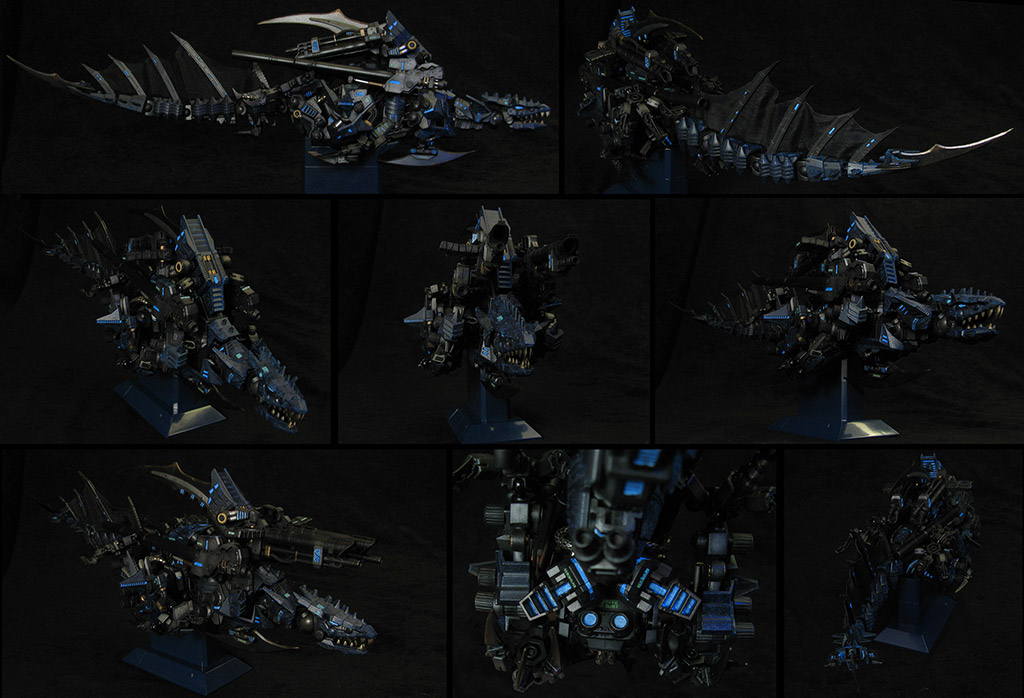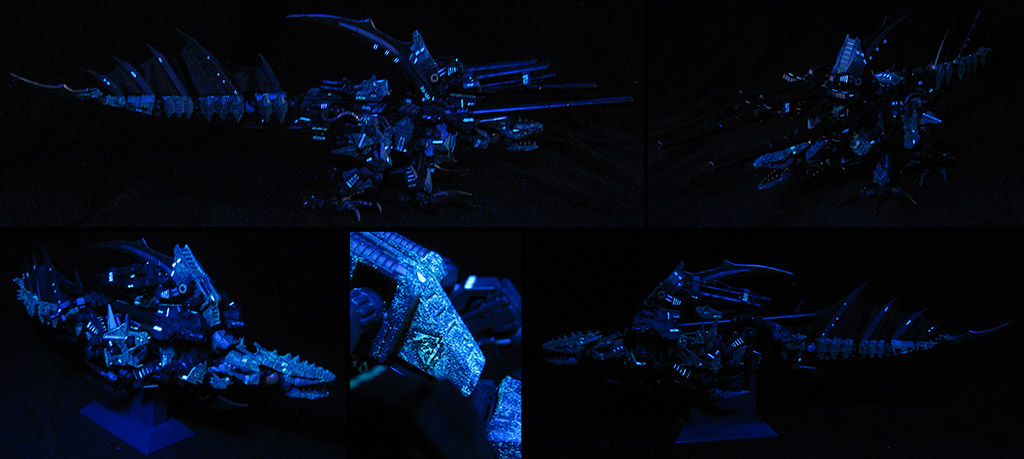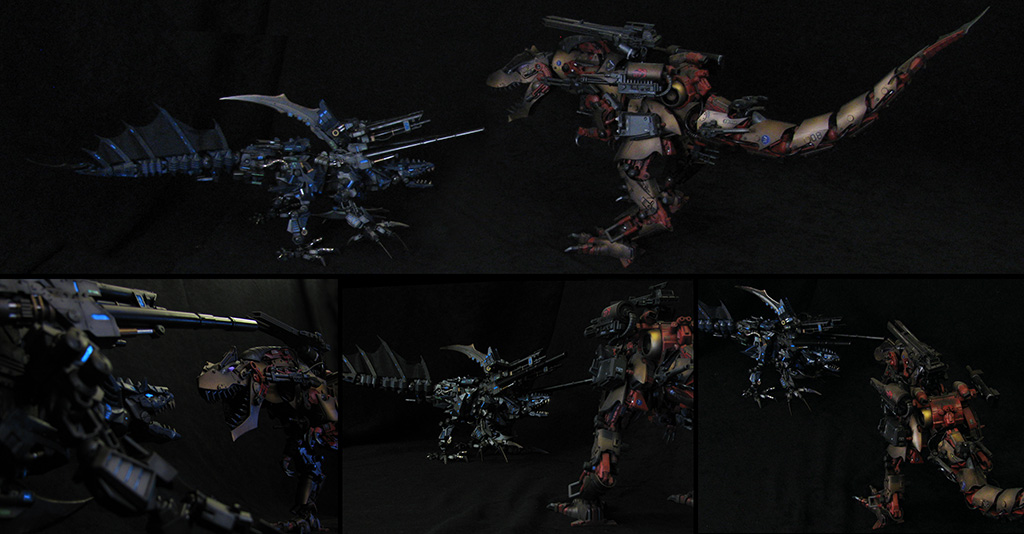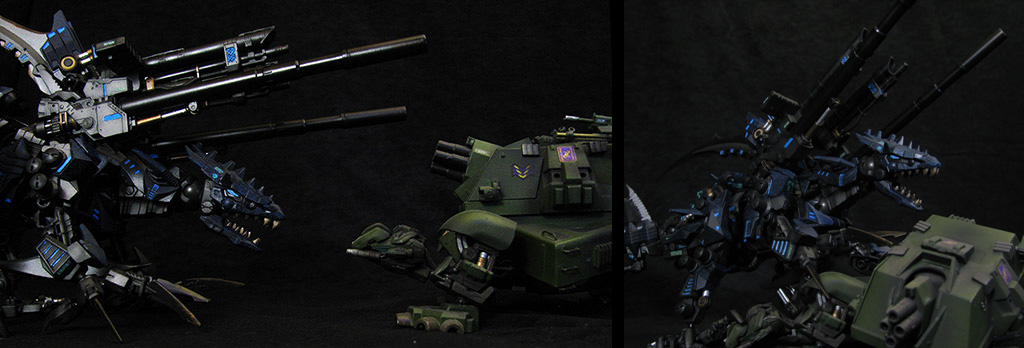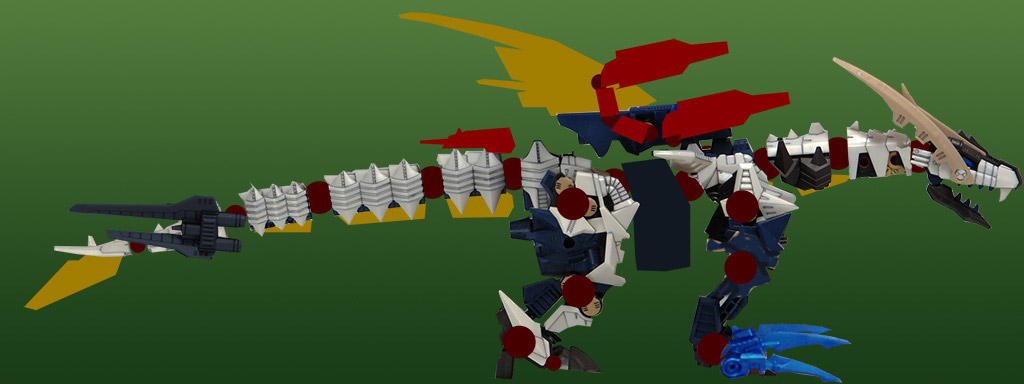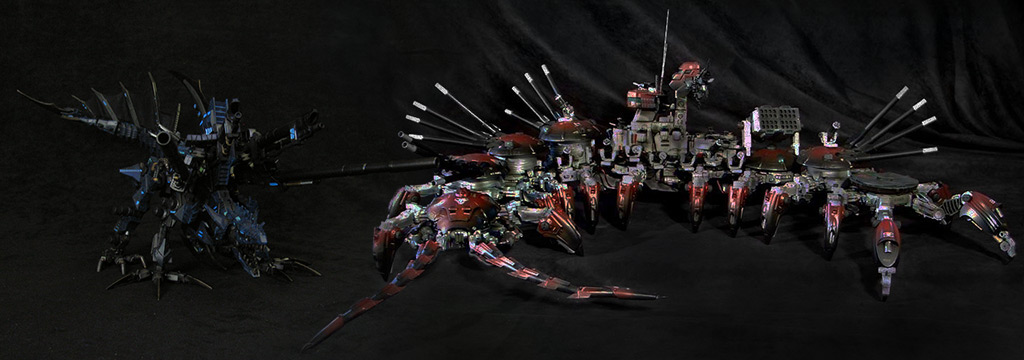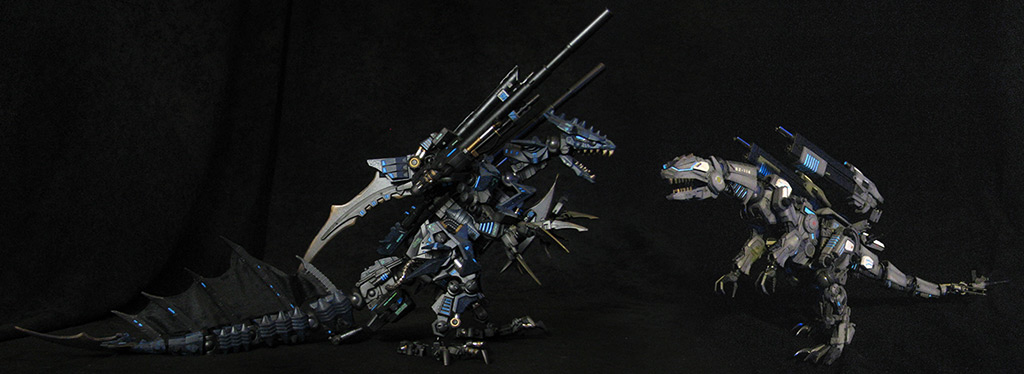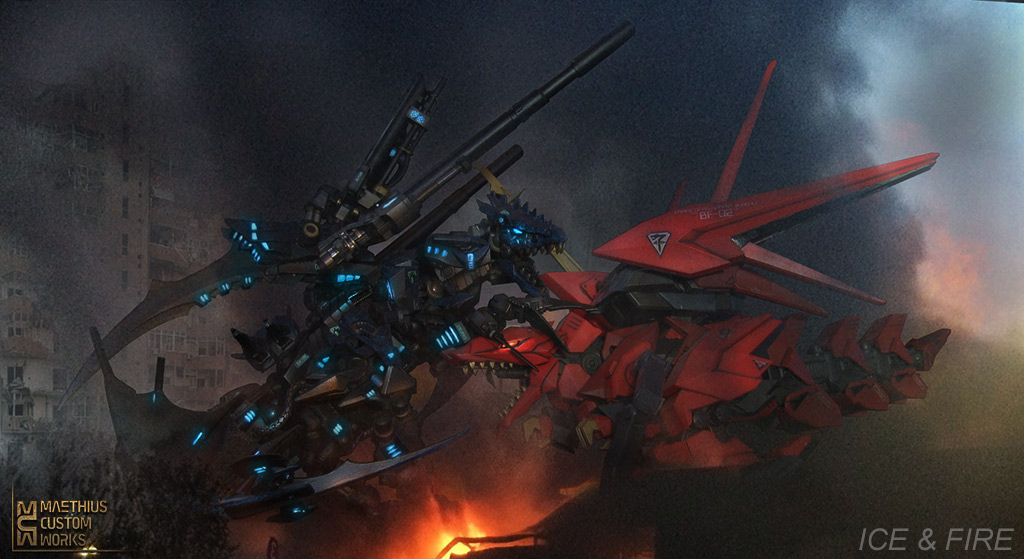Unit Data
Classification: Celestis Tenebris
Type: Amphibious Dragon
Primary Mission: Maritime Superiority Platform
Secondary Mission: Terrestrial Assault & Bombardment
Power Plant: DPZ (Dynasty Hyper-Infusion Core; Type 5)
Chassis: 327
Crew: 2 - Pilot (minimal rank requirement: Lieutenant),
Statistics
Length: 51.2 meters (Decalto Dragon: 27meters)
Width: 13 meters
Height: 14.8 meters
Mass: 180 tons (Decalto Dragon: 120 tons)
Performance
Land: 130 KPH
Sea (Flank): 16 knots
Sea (HPOS): 60 knots
CAPABILITIES (Chassis)
While the original Decalto Dragon was a tough and durable aerial platform, it was considered a medium to light Zoid when facing ground opponents of similar mass. The Celestis Tenebris was not intended to race into battle and hack and slash its way across the field. Rather, it was intended to be rapidly deployable in water and capable of maneuvering its artillery quickly into position on land, and defending its position with minimal support. To meet this new mission, the chassis would be reformed with stronger load-bearing technology, superior armor, and an updated evolution of the Zenevas Empire’s OHFS (Oscillating Hydrodynamic Force Shield) system used to propel the EZ-411 Tsunami through the water.
HISTORY
Along with the proposal of the Gil Kaiserin, the Dynasty intended to create a new team to implement a new combat strategy. The Gil Kaiserin and Lucht Vuur were well into development and would constitute strong aerial and ground support assets, but another engineering branch was tasked with the creation of a new front line Zoid that could take the ground. A terrestrial version of the Decalto Dragon was in work when orders came down from on high that another asset, a marine support Zoid, was also in the bidding. The Decalto team quickly adapted their design and realized they had the makings of a never-before-seen platform; an amphibious assault dragon. The project was named Celestis Tenebris, “Dark Typhoon”… an ocean storm that would wreak terrible destruction inland. The design was finalized for a Zoid that would be as capable a naval vessel as a battlefield asset.
ARMAMENT
The weaponry carried by the Celestis Tenebris is engineered to maximize effectiveness in its two environments. While submerged it relies on either undersea missiles or heavy melee weapons, while on land the primary focus is on long range artillery. With its improved Deochalcum power plant, the DPZ-305 relies heavily on energy weapons balanced with a deadly array of monomolecular blades for infighting.
Peerless Systems EPC12b 155mm Beam Cannon (x2) – armature mounted, 60° forward arc/ 60° rear arc
The Peerless model EPC12b is technically the mainstay weapon of the DPZ-305. It is powerful enough to cause considerable damage to even heavy targets at ranges up to 5 kilometers, but can punch through lighter targets some 20 kilometers distant. A redundant cooling system was added that allows the gun to fire a beam every 6 seconds, rivalling the speed of many projectile-based systems. Submerged, the EPC12b can still damage targets more than 100 meters away.
"Stormcell" 15" Rail-Assisted Ordnance Launch (RAOL) System (x2) – armature mounted, 60° forward arc/ 60° rear arc
Looking like a massive cannon, the Stormcell is actually a magazine-fed, rail-assisted missile launch system. The magazine can be loaded with missiles, and each may be of a different type. The general load for the RAOL is a medium cruise missile with an APEX warhead. The magazine doubles as an external missile pod launcher, and the weapons can be released wihtout the use of the RAOL itself, even simultaneously. Missiles launched directly from the magazine quickly achieve MACH 4 and can track down and strike a target up to 80 kilometers away with exceptional accuracy. Using the RAOL, however allows the same projectile to launch at MACH 6 and increases range to 200 kilometers.
"Overlord" 280mm CERC (Coelesced Energy Round Cannon) (x2) – armature mounted, 200° lateral arcs
The huge Overlords were designed to fill the niche of a heavy artillery piece while avoiding the reliance on carrying many tons of ammunition. The "magazine" atop the barrel is a particle compression chamber that essentially creates a "round" out of a stasis-controlled particle cannon shot. Rather than loosing a beam like other particle cannons, the CERC projects a compressed beam projectile that slams the target like an artillery shell. The system creates a round over the course of about 20 seconds, then launches the round up to 240 kilometers. It can even arc its trajectory to a degree, allowing the CERC to fire over obstacles and terrain features up to 45 meters high.
120mm Quantum Hyperflux Gravity Cannon (x2) – rear turret mounted, 360° arc
This weapon is a similar system to that found on the mighty Gil Kaiserin, but it is more compact and delivers approximately half the damage. That is to say, a direct hit can crush a Gojulas into the size of Arosaurer before it explodes into a field of debris three acres wide. The weapon can destroy virtually any target at 7 kilometers but requires 20 seconds to recharge. For this reason the guns most often alternate to increase rate of fire. On the largest targets at maximum range, however, both guns can strike with cataclysmic force, but there is a risk of the gravitational forces damaging the Tenebris.
Baedrig "Recourse" 85mm Autocannon (x2) – Integrated construction, fixed forward
Hidden behind shroud of neck armor and mounted alongside the HCPC are a pair of 85mm, gas-operated autocannons. Each is belt-fed from an internal magazine of 800 rounds, which can be emptied of ammunition at a rate of 5 rounds per second. The weapon has a range of 16 kilometers versus soft or aerial targets and can penetrate moderate armor within 5 kilometers.
"StarBlazer" 155mm Beam Cannon (x2) – turret mounted, ventral tail, 360° arc
Beneath the tail is a compact turret featuring a pair of beam cannons to defend against rear attacks. While they are most effective in open air with a range of 15 kilometers, they can actually be used while submerged within a few hundred yards. The guns are effective against most common forms of armor with a concentrated burst, requiring a 10 second cooling period. Against lighter targets the StarBlazer can cycle every 3 seconds.
Compact Hyper-Charged Particle Cannon – Integrated construction, fixed forward
The C-HCPC delivers half the damage at half the range of its larger bretheren, however, it boasts the advantage of doing so in half the time. When not in use the unit is hidden beneath the heavy armor shielding of the neck and shoulders. It takes only 15 seconds to charge and need only be exposed just before firing. Even with its greatly reduced state, it will decimate most common battlefield units in a single shot, and the reduced recoil means that the Celestis Tenebris can immediately switch to conventional weapons and maneuvers while the C-HCPC recovers for the next burst.
Monomolecular Edged Blades (x2) – integrated construction: fore-claws, tail spike, and tail axe
These weapons are "grown" and shaped organically out of an alloy engineered to reduce to the width of a single molecule at the edge, allowing it to cleave through pretty much any physical substance. Replacement of a blade, should one actually fracture, is required; they cannot be field repaired.
"Hullbreaker" Blade (x2) – integrated construction, dorsal and ventral mounts
The Breakers are both extra heavy monomolecular blades, as with the claws and tail weapons. However, these weapons discharge an immense anti-gravity pulse that shred units apart as the edges penetrate. The Hullbreakers are also used as steering fins, increasing submarine maneuverability.
SUMMARY
The Dynasty is all too aware that its position is one of quality over quantity. The DPZ-305 Celestis Tenebris is also testimony to the principle that Dynasty engineers must create multimission platforms that excel in all of their roles. The combination of maritime stealth, heavy artillery support, and some of the deadliest close combat per mass makes the Tenebris one of the deadliest of the newest strain of Zoids. Coupled with the AI-2 profile of a hunter-killer, and the DPZ-305 becomes one of the most terrifying weapons on the field.
FROM THE SKIES TO THE SEAS
Counting the Gil Kaiserin Supreme King Gojulas, and the six Royal Guard kits, the Celestis Tenebris was definitely the most ambiguous, organic, and uncertain custom of the series. The very first idea was so simple; articulate a Decalto Dragon and paint it in my Age of War Guylos scheme. That changed to, “what if we made it into a terrestrial dragon, since we’ve already got three in the lineup (Gil, Vuur, and the redesigned Gungy) and swapped out the wings for artillery?” Okay, so I started to look up land dragons and saw that the Decalto, indeed, had some great forms to work with. But as the project began we looked at the custom again and expanded it to, “since Guylos is a sea-dominant nation, maybe we should make this custom a marine dragon to aid in the defense of the Deadalos and command the Angstmorders.” We switched gears into aquatic mode, then we settled on the final course of action; an amphibian dragon that could lead the fight in the water and bring its artillery onto the land.
AI-2 Profile
Celestis Tenebris are devious brutes; their personalities are well-suited for silently stalking their prey over weeks of time and for ambush tactics requiring long, silent stretches of inactivity. But once the attack begins they fight with the viciousness of three Ligers. They relish both the long chase and the kill, the portion of combat they find tedious is when they are called upon to offer artillery support. This isn't to say they are not good at this task, but it lacks the anticipation of the hunt or the excitement of the close kill. They tend to be more bestial in personality than Gil Kaiserin, but share many of her attributes. When the time comes to choose sides, it is a coin toss if a Tenebris will retain its Guylos allegience or join the Zoid Empress.
STRETCHING THE CORE
Like all customs, there comes a time when you stop planning and start hacking. I opted to cut the torso into three segments rather than two. Each cut represents an additional inch of length, and this custom needed every bit of length it could get. I first chopped out the middle of the torso and focused on that, building a structure that was strong enough to mount a pair of Struxx joints. I drilled and cut until the Struxx part could slide onto the internal screw pegs that ran through the core. Once this piece was glued like mad, I modded a pair of Struxx joint cups to fit snugly into each other, the tongue and groove locking together inside the ring atop the post. For safe measure, I drilled three screws through the most key areas I knew would require strength.
As a side note; my client and I had also decided that an aesthetic component that could work very well with this custom would be to place cloth weather seals between the torso segments in the same manner as I did with the SKG. This also meant that the work I did inside the shells didn’t have to be pretty or even painted, so I didn’t have to be shy about building for strength. I will doubtless use this technique a great deal more as I perfect it.
RE-IMAGINING A BLOX KIT
Blox architecture is completely different from other kits. Rather than having a couple pieces that represent a neck or tail, each of those parts is assembled from a shell and all of the ports that allow the interchangeable parts to lock in. Also, Decalto’s limbs are a mixed bag; the rear legs are very complex and the front legs are basically hollow plastic sticks. The torso is VERY short for this size kit; clearly designed to be a biped, there is only room for four legs if they don’t articulate much at all. The more I examined the kit’s architecture, the more I saw the challenges multiply. The last major decision I decided to risk was flipping the torso. The Decalto has a high neck and tail which would have been fine had we kept with the land dragon concept. When I looked at sea dragons, though, it made more sense to lower the neck and give this build more of a shark-like profile. This also placed the battery door at the back, which gave me ideas for how that could function in the end.
HIP-CHECKED
After over-building the abdomen I decided the next hardest piece would be the hips. The hip requires four joints with a bizarre architecture influenced by two factors: the most solid structure I could manage (almost always means Struxx) that it would be beyond view behind the cloth curtains. I had to rig the hip post first, which was exactly the right length, then I needed to trim the new spine posts so they were not hanging out much too far.
LOW BACK ISSUES
Many posts and sockets were trimmed but there was still too much wiggling, so I placed thick plastic washers around the hip post to really hold the entire assembly steady. With the cuts made I was able to obtain a pretty clever angle with the joints. One of the reasons for that upward slope is because I didn’t want the tail or midsection to sag; by angling the joints sharply they could still flex in three directions but would support the heavy tail and front end for more dynamic poses. I intended that this custom may require a stand to maintain a swimming pose, so less bendy in the middle was desirable.
BLUE COLLAR WORK
With a high spine, a low neck, and two smaller, far-forward shoulders, all stuffed under the battery compartment door, this was going to be fun. Struxx have come in so handy since I started using them as joints, but in the several of my commissioned builds they have also proven perfect for providing strong internal structures. You can see here that the “Y” joint wedges into the cavity perfectly and has a perfectly placed socket for the neck joint to plug in. The spine, however, required some drilling, a lot of glue, and a screw just to be safe. You can see in the final shot how the joints linked up to reform the torso, and keep the pieces visually centered despite the odd angles of the joints. Remember that these will be hidden behind cloth.
BLATANTLY BENDY
When I build torso flexibility into a custom I know that, in the end, most of it will be limited by limbs, cables, and, in this case, fabric, so I try to build in as much as I can before I pare it down. Before placing any parts onto the body, it could flex almost 90° horizontally, and almost 20° vertically.
SHOULDERS & ELBOWS
Sometimes things pan out naturally, sometimes... not so much. In the case of the shoulder pieces a trimmed down Bionicle joint slid solidly into the shoulder sockets. The elbow, however, was very difficult because the Decalto Dragon's front leg (Parablade's leg) had some awkward shapes and was essentially a large, hollow stick of plastic. I measured and cut the piece in half so I would have enough material to install the joints with any kind of strength. The upper elbow fit a Bionicle almost perfectly, but I needed to cut out a peg to slide through the joint since it would be fiddled with a lot. The lower part of the joint requiered another post be made and the Bionicle ball joint be drilled and carve a lot to make for a solid fit.
CAPABILITIES (Submerged)
The Celestis Tenebris was constructed to fulfill two distinct mission types, and do so with equal efficiency. The first role of the Zoid is to bolster the marine defense grid as a submerged patrol and interdiction unit. The Decalto Dragon structure was redesigned to function at depth, but retains the agility it bore in the air. Under only physical power, the DPZ-305 uses its micro-mesh sails to propel itself through the water in silence with a cruise speed of 20 knots. It incorporates a directional hydro-thruster system to achieve a higher cruise speed of 30 knots, but at the sacrifice of its virtually silent state. Finally, the Tenebris incorporates an updated version of the Zenevas Empire’s OHFS system, which creates blades of force that function like oars to draw the Zoid through the water. With all systems active it can reach speeds of 38 knots, making it an able interceptor. Just as often, however, its aquatic mission is only to transport its firepower to a beachhead or battlefield.
CAPABILITIES (Combat)
While the Celestis Tenebris is not as speedy or agile as Ligers or Dibisons, it is a brutal infighter. Its reinforced chassis and low stance make it particularly capable in close combat. The powerful limbs and massive claws can deal terrible damage, and are so large that it is capable of outright grasping something the size of a Saber and crushing it to the ground while raking it or biting it with powerful jaws. The tail is very heavy and ends in a combination sword and axe, both mono-molecular edged diamond serrations. A final addition to its more obvious physical attack prowess, the Typhoon can also supercharge not only its melee weapons but its whole body in combat, allowing it to blow out sensitive electronics, scramble sensors, or even kill pilots on a single contact. Energized in this manner, bites and claws are even more of a threat, even to very large opponents. Though restricted almost entirely to submarine fighting, the gigantic Hull Breaker blades can tear through armor and maim even a Whale King.
ZOID PARTS
Decalto Dragon
Base Kit
Kotobukiya HMM Liger Zero Panzer
"Stormcell" RAOL, "StarBlazer" Cannon
Robostrux Radox
Fin Spines
Dimetra Pteras
Ventral "Hullbreaker" Blade Mount
Shield Liger
Ventral "Hullbreaker" Overchargers
Gravity Saix
Dorsal "Hullbreaker" Power Regualator
NON-ZOID PARTS
Gundam Heavyarms
"Stormcell" magazines, Gravity Cannon Joints
Gundam Amazing Weapon Binder
Gravity Cannon Barrels
Asoblocks
Intakes, Various Joints
Struxx
Torso Joints
Aluminum Pipe
Cable Guide
Rayon Cords
Power Cables
Kotobukia MSG - WU #2
Shoulder Armor
Soft Soap Dispenser
"Overlord" Cannon Muzzles
G.I. Joe Mountain Howitzer
"Overlord" Cannon Muzzles
Sheet Styrene
Wings, Various Details
Rayon Cloth
Dorsal Fin, Torso Weathehr seals
Computer Bits
Dorsal Power Interchangers
BUILD NOTES
CUSTOM HOURS: Build: 26 - Paint: 9 - Assembly: 6
Articulations: 53 - Cables: 16
BUILD "FIRSTS"
First time articulating a Blox/Fusors kit
Most flexible custom to date
DEFENSES
The Tenebris’ skin and armor appears slightly differently than its contemporary units due to a coating of an acoustic dampening material (ADM) that resists the reflecting of sonar pulses. The angular nature of the Zoid’s structure combined with the micro-forms within the skin help to direct reflected sounds away from the point of origin, greatly limiting the accuracy of sonar and other acoustic sensor systems. On land the ADM coating serves to reduce radar and other directed wave sensor systems, but not to the same effectiveness as sonar. Far from being limited to a propulsion system, the OHFS technology creates a flexible shield as powerful as a Liger Zero with the added benefit of striking defensive blows against melee combatants.
THE BUILD
GALLERIES
CAPABILITIES (Land)
The Guylos Zoid Engineering Core, or ZEC, wanted to ensure the Dynasty that the Celestis Tenebris was just as capable on land as in the sea. Though it is designed to propel it through the water (even the forward claws lock into bladed flippers), the huge feet enable it to grasp the earth and charge forward on land. It can cruise at a speed of 90 kilometers per hour, but can maintain a run at 130 KPH. Because they are core-venting the hydrothrusters can still function on land, angling to assist in short bursts of speed up to 200 KPH and helping it to leap more than 50 meters.
FEELING HALLOW INSIDE
The next big challenge with the front legs is the large hallow area where the old "heel" would fold into . There wre no structural features I could really use to anchor any significant foot replacement (for the nasty, ugly chunk of plastic that normally goes there). This time my rescuer came in the form of Asoblocks, which are also apparently on the discontinued list. (Companies, stop cutting off my customizing supplies!) The first piece I used cut into the calf very well, was strong as can be, and included a very solid ball joint. The front feet are basically all Asoblocks but with the Death Raser's scary-long claws installed into them. In the final shot you can see how huge those claws become when they are not merely hanging from the chest; I placed them by the original foot and a Bionicle foot I was considering for the new hind feet.
BACKING UP
Building up those large, flexible front talons worked out really well, but it left the back feet feeling terribly small and static. I decided to use some Bionicle parts to replace the hind feet with something larger. They were so large, in fact, that their lack of flexibility was no MUCH more pronounced. There was nothing for it. I created some basic articulated feet structures using Asoblocks and then chopped up the Bionicle feet so I could mount each toe on its own joint. The back half of the Bionicle was used as a sort of foot-lock stabilizer for when the Tenebris fired its main guns or to give it an edge in melee combat. I filled the gaps with some plastic dome-headed pins that really helped it look more solid and complete.
PUTING YOUR FEET UP
One challenge I knew this custom would face was the tail; the original kit was basically a square stick. Even fully jointed it would still look very inorganic in shape. I wanted to give the tail some kind of taper, and that meant creating a larger base. I used Parablade's body, but the shape was still very awkard and narrow. I came up with the idea to mount boosters to push the Typhoon through the water. I had the discarded feet of the Gil Dragon handy, so I hooked them up using another Asoblock, allowing the boosters to pivot. The exhausts could open and close. After building the structures I also found the perfect necklace to plug into the Blox ports to give it a high-powered look. As a side note, I had considered hollowing out the cockpit and making it an aft missile pod, but I liked the dynamic of this custom having a gunner and kept the position open.
TAIL SEGMENT #1
Blox segments are comprised of two shells pocked with open holes that are stufffed with a half dozen plastic ports. These lie about loosely if the shells are separated. Worse, the "details" and features that help the Blox parts look unique from one another are all tacked to the outside, so you must re-engineer each segment by first hollowing it out, then placing a strong core to hold the new joints, shave each of the Blox sockets and set them back where they go, re-assemble them, then trim all of the armor and external bits (because the new structural spine infringes on the depth of the holes), and finally it can all be reassembled. If only that could be duplicated for each, but no... each section is completely different.
TAIL SEGMENT #2
Since the second segment is one set of Blox ports longer, you can't just duplicate the way the first segment was constructed. Further, there is a Struxx ball joint on one side and a Bionicle socket on the other. Also, the plastics used in both Bionicles and Blox parts is very slick, and does not hold adhesive well, requiring each to be scored and roughed up before it is glued. I also decided to drive a screw into the Bionicle joint to secure it. On the Struxx end, I needed to make a new wall out of styrene (bright blue) to keep the joint form moving at all. A final note; each tail segment ends up as almost solid plastic, and weighs far more than it did as a Blox piece. That means more joint strain.
TAIL SEGMENTS #3 - #5
For some foolish reason, I've only got the parts photo for segment #3, but it is essentially the same as segment #1 but using Bionicle joints. I know, it would have been nice to have that internal pic, because it really was a cool bit of work requiring a pin glued through to modified Bionicle pieces that fit perfectly the need for transitioning to smaller but still strong joints. The second picture, however, shows how I divided the final tail segment into two pieces for added flexibility. For the new #4, I affixed a Bionicle ball joint to the peg of the tail segment by drilling a hole through the ball and then driving a small screw through it. To place the socket in the other end I affixed a long Asoblock piece through it. The Asoblock joint happens to be a perfect fit for a medium Blox ball, which I then transitioned into a rubber Blox gasket that I mounted in the new Segment #5.
STICKING MY NECK OUT
Flipping the torso over swapped the chest-mounted cannon and high-mounted neck for a lower, more sinister silhouette and a back-mounted gun. Adding two joints to the neck almost doubled its length.and gave the head a quite wide range of movement. I had to hallow out the neck, as with the tail pieces, and replace the sockets, but only two. I modified a Struxx shaft to bring it down to size and lock around the screw post to keep it strong. Originally the intent was to use a modified Decalto Dragon head, but in laying out the pieces it struck me how aggressive and full of character the skull was without any armor, (and I can't recall seeing a custom using the naked Death Raser skull). One problem was the skull has no canopy, and the armored cover hinges at the nose from the armor. Another issue was that the body size had doubled, and the head, without the armor, looked half the size it used to be.
HEAD GAMES
From the start I wanted to use the head and neck armor from both the Death Raser and Decalto Dragon forms... but that armor only stays on with the side panels. Unless, of course, you only use the nose portions to secure the piece around the snout. To keep the head armor in place without glue or pegs I installed a magnets under the pilot's console and in the nose. I planned to add some teeth to extend the jaw and balance the size of the head.
TOOTH-HURTY
I have had the teeth of a Kotobukya Liger Zero hanging around for a while. I decided that they would be perfect way to extend the jaws. The Celestis Tenebris's head is one of the most vicious I have seen on a custom, especially using almost all stock Zoid parts. The front view on the right is small for context, but you can see those horrifying teeth and the scowl from the dragon's skull. The result reminds me of the Skeksis from The Dark Crystal.
ONE GOOD TURN DESERVES ANOTHER... AND ANOTHER... AND ONE MORE
Not really a transformer, but the reveal for the hidden HCPC turned out pretty well. The chest armor swings downward, which allows the whole neck to do the same. While in that downward position, the neck's wrap-around armor cowl can lay flat against it, and this clears the barrel of the HCPC and its pair of lighter support guns; the "Recourse" 85mm autocannons.
A WEAPON OF A HIGHER CALIBER
I wanted to make use of the cool chest gun of the Death Raser but I could see it as a battleship style turret as opposed to a forward-fixed weapon. I also decided that the guns would have to be of a higher caliber and I wanted to be able to articulate them. The turret component itself was comprised of the wheel and peg from the backpack mounted through a deck of styrene. To articulate the guns I used the shoulders from a Gundam Heavy Arms kit mounted to posts I clipped from a sprue tree. The barrels themselves were provided via a very old Gundam Amazing Weapon Binder set. My client and I both liked that the oval barrels were remeniscent of the Gravity Cannon upgrade I gave to Gil Kaiserin.
WARSHIP DRACONIS
The turret is sized to tuck under the armament backpack. It rotates 360° and can angle almost 90° upward. I was originally conflicted about if I should use shorter, wider barrels and keep the mounting pegs near the rear cockpit or if I should keep the long barrels and shave the posts and use them to mount some sort of boosters or weapon system. In the end, I opted to keep the turret unobstructed and trim the posts.
MAIN GUNS
I knew that the Celestis Tenebris would sport some heavy cannons, but wasn't sure the direction to go on them. I considered mounting modified Buster Eagle guns to back-mounted armatures that replaced the original wings. But the spacing between the shoulders and the body was too narrow to stow the cannons, even with the Blox pegs sawed off. I opted for an original gun made from half a dozen part sources. The main housing is from the HMM Liger Zero Panzer kit; I even kept the armor off of them to keep them narrow enough to stow. I had plans for the barrels of the Panzer guns, so I replaced them with the ends of the Buster Eagle barrels (since I mauled the housings), The Panzer internal mechinisms fit instide the barrels almost pefectly! They were still a bit too stubby for my tastes (I felt the Typhoon's guns would need massive range so it could offer fire support from the shoreline) so I extended them using a soft soap pump and the muzzles from the GI Joe Mountain Howitzers I used to make the legs for the SKG. To mount the new guns, I removed the magazine (which is really too small to be of any use to such a high caliber gun) and installed an Asoblock piece for the joint. I moved the magazine forward as a sort of hypercapaciter. I then built a support strut using a Blox port, some HMM Schneider pieces, and some tube styrene. The final touch was to drop a couple of standard rivets into the holes where the Panzer housing was supported by the gun carriages.
COMBINATION CANNONS
Remember those advanced-looking Panzer cannon barrels? I decided they should be used to make a kind of torpedo railgun. First I had to reconstruct the inner backpack mechanisms to support the armatures. The joints were made to flex up and down to flap the wings, and I held them fast by plugging them into pieces of water bottle tubing. I then took the original flap lever and cut a notch through it that would hold them tubing securely. Now I could affix ball joints for the main cannons to the forward pair and use the rear pair as-is to mount the torp-guns. For those I used the arms of the Parablade; flipped upside down, they reach over the main gun joints and drop down in front of them. I sawed off the hands and left a vertical shaft that used to be the forearm; I also sawed off the excess protrusions from the joint. A bit tricky, but I drilled a hole through the back of the Panzer cannons. When assembled the guns around the arms, I ended up with a pretty cool-looking armature that arced the guns in place and allowed them to swivle to the sides. The last two features I added to the torp-guns were smaller beam cannon barrels to give the Celestis Tenebris some more modest firepower options (and to cap off the hoses that used to disappear into the Panzer cannon housings) and a pair of external magazines made from my well-used Gundam Heavy Arms. These weapons look very utilitarian, and stow away nicely to create a strudy-looking hump over the Typhoon's shoulders.
MAIN BATTERY: CHECK
Some quick shots to show the main weapon systems of the Celestis Tenebris. The pictures to the left demonstrate how the weapons look locked in the forward position and stowed to the rear. To the upper right you can see the torpedo cannons (actually underwater missiles), the barrels mounted over the secondary gun systems. You can also see the torpedo magazines that enable the Tenebris to carry 14 rounds of cruise missiles. The lower two frames show the weapons locked forward and splayed; a configuration that allows Zoid to spread its heavy artillery love out to about 160°. At this stage the dorsal HCPC had not been installed yet, so add in a 5th, central gun of doom to this shot!
WINGING THE SAIL
One later feature that evolved from vague concept to specific pain in the rear end was some kind of spiny sail, but not one like Dimetrodon or Dark Spiner. Ironically, I had a spare pair of wings from a Radox that was being reserved for another custom, so I was able to obtain the parts for the sail without much difficulty. Actually, designing the sail was more difficult than getting the parts together. The pieces clipped from the wings would, in turn, but cut into enough pieces to generate five two-sided spines to mount one per tail segment. I had also played with the idea of ventral fins, but they simply restricted the leg movement too much or made the beast look like an irritated fish, so they were dropped.
STANDING UP FOR ITSELF
At first I had worried that the spines wouldn't be tall enough. Once they were placed on the model I could see they were quite large enough to carry off the effect I wanted. The scary part was that each one mounted differently, and that I would not be able to actually see how the sail would turn out until AFTER paint was finalized!
BREAKING GOOD
First of all, this chain is simply one of the coolest looking, best functioning large cables I have ever used. The style of necklace chain looks like an armored hose, it is among the most flexible of any size chain I have used in any custom, light doesn’t penetrate it like a typical “lantern” style chain, and, in this case, the end caps are a flawless fit for the Blox holes. That said, there is a little more to the heavy cable that links the tail to the body than really cool aesthetics. Shipping one of my customs can be excessively expensive (imagine a $800 model that costs $130 to ship), so I now plan on shipping at the start of a project. In this case the Celestis Tenebris is built to break in half at the tail so it will fit in a more compact box. I chose the look, placement, and size of the chains to allow the new owner to effortlessly snap the tail joint back together and then plug the cables in so that the look was seamless. To hold the cables at the right angle behind the hip armor, I cut a pair of aluminum rings and affixed them in the crevice. Plastic rings were too thick, and the aluminum allows the cables to slide very smoothly.
BITS AND PIECES
Unlike many of my customs, the Celestis Tenebris doesn’t really suffer from a lack of detail. There are a few places where I wanted to add a visual or structural feature, but not many. I used my Kotobukiya MSG kits and Bandai custom parts sets several times on this build. Noteably, I placed exhausts on the back of the gun turret, as well as a maintenance hatch, vents at the back of the tailgunner segment, dressed up and added a mounting port to a Liger Zero double impact cannon to be a ventrally mounted aft defense cannon, and a few extra bits from a Gravity Saix alongside some computer parts to give detail to the dorsal fin.
THE HULL BREAKER
I had an idea for this piece of gear ever since we opted for an aquatic platform; not a shark fin so much as a weapon designed to undercut the hull of a ship or large marine transport Zoid. I was also a bit inspired by the kaiju look the beast was taking on, especially the design of Mutavore featured in the film, “Pacific Rim.” I had originally considered making this blade articulated as well, but too many large moving parts were beginning to make stability an issue. The blade is supported by the original Parablade horn that was used to adorn Decalto Dragon’s head
THE KEEL CLEAVER
Having added a massive dorsal blade looked wicked, but I couldn't leave well enough alone. The Celestis Tenebris also received a huge blade on its chest. Part of this design also stemmed from Pacific Rim's kaiju, Mutavore, which features several axe-like bladed protrusions. This weapon would allow the Typhoon to swim over a submerged Zoid or submarine and lance it through or chop the hull. Also, since it was built on a peg, it allows the blade to rotate like a giant rudder, giving the Tenebris greater agility underwater.
ALWAYS ANOTHER BARB
I seem fond of scimitars. I wanted to try something a little different for the Celestis Tenebris’s tail weapon; a combined sword and axe seemed like a good fit. A sword blade makes for a nice shape to end a tail, and with the tail’s leverage and arc it is a logical choice. But Tenebris is also a brute, so I included the axe blades, which can serve as horizontal control planes as well. To attach the weapons, I used the piece I shaved from the neck armor that covers the HCPC. This worked very well to not only hold the blades in place but the spines off of the armor give a nod to a trident.
HOLE PLUGGING
The Decalto Dragon is covered in holes. I know they were created to enable part swapping with other Blox kits as well as to provide ports for CAS options (that never happened) but when creating a non-Blox custom, they are a serious detriment. I used two main items to cover holes: 3/16 vinyl hole plugs (which fit perfectly, by the way) and standard rivets. The plugs create a slightly textured dome that, to me, really added to the nautical feel I was trying to achieve. The rivets were used for when space was a premium, lying flat against the body where clearance was an issue. In addition to capping holes, I also plugged a few. In the third image you can see that I re-used the Blox posts I cut from the Buster Eagle’s cannons. These enabled me to fill the holes in while taking up ZERO additional space, which was required where I had engineered the neck armor to slide down in order to expose the HCPC. Picture #4 shows a fourth way I covered some holes; in this case, Asoblocks have their own sockets, but they are a little smaller than Blox. I decided to not only cover the unsightly and thin ankle piece, I used the posts I cut from the tailgunner station to both add a reinforcement to the leg and give me a post to place a rubber cap to emphasize the trademark Zoid look. I also made some holes. In frame #5 I glued in some of the steel necklace segments I used as Gil Kaiserin’s cannon barrels as anchors for chest and belly cables. And, of course, I also needed to replace posts that were removed when I added joints so I could replace rubber caps. In the shoulders I didn’t want to play with cutting and shaping posts, so I just drilled a screw into the hole that had the same diameter as the original plastic peg.
FROM BITS TO BADASS
The parts all come together to form one brutal critter. More than twice the length and more than twice the height of the original Decalto Dragon (admittedly, because of the really big knife on the back) , the Celestis Tenebris ends up as a cohesive model with a unique silhouette among customs. As far as I know. ;-) To complete the silhouette, though, requires the membranous sail on the tail, and that can't be made until AFTER the dull coat.
A SINGLE SHADE OF BLACK
Once again, things start to look far less random when you paint or prime over the myriad colors of parts. Out of the 84 components shown here, 14 required masking for at least two base colors. All told, paint was pretty simple on this model.
FIRST BASECOAT
Some quick sample shots to show the base scheme for the Zoid's structural components. I chose to use a dark gunmetal airbrushed over the black, leaving some smoother transisions between plates and details. Gun barrels, engine exhausts, and other details were painted with burnt iron. I went with flat brass on the hydraulic cylinders I also painted various details burnt iron. On top of this I also placed my custom neo-Guylos labels.
TOPCOATS
This shot does a pretty good job demonstrating the two topcoats I used on this custom right next to each other. The gun carriage and most of the body is painted with transparent matte coat. The gun barrels and blades, including the claws, were painted with a gloss topcoat. At this stage the hydraulic pistons have not been painted. To get the chrome finish fthey need, the pistons must be painted ofter the topcoats.
GALLERY: FINISHED MODEL
Fully outfitted, the GPZ-305 stands completed. It is the most flexible custom I have ever made, capable of crossing its tail blade behind its head.
GALLERY: STRUCTURAL ASSEMBLY
Beneath the armor and virtually stripped with weapons aside from those attached to the frame itself, the Celestis Tenebris still looks deadly. In this form it would be a whir of blades, but it is also armed with its rear guns and HCPC. What it lacks, however, is a canopy for the pilot station.
GALLERY: THEROPOD STANCE
The idea of standing the Tenebris on its hind legs was an afterthought. I had finished shooting the model when I tried it on a whim, and then I added another two more hours of fllming. In this mode the Celestis Tenebris actually more resembles Death Razer more than Decalto Dragon. It suddenly becomes a lethal wall of knives. A truly deadly serendipity.
GALLERY: NAUTICAL FORM
From the time it was decided that the new Decalto custom would be a sea dragon, I knew I wanted it to be more than a swimming lizard. The flexibility of the model and its ability to stow its weapons influenced me to give it a purely nautical configuration. A truly menacing figure in the dark waters of Zi.
GALLERY: LUMINESCENT PAINT
While all of the new generation of Guylos models have luminescent armor, the Celestis Tenebris is uniquely blue. It is also more of a marbled pattern that gives a nautical, wave-like feel than the other, green models. Hidden on the dorsal intake over the neck is the sigil of Gil Kaiserin.
CELESTIS TENEBRIS vs. SHIELD LIGER COMMANDER
I dusted off this old kit for a different, iconic Zoid to demonstrate scale. However, I also noted that the two units had some similarities: both have huge cannons mounted to armatures, secondary and tertiary heavy guns, and sport missile/rocket tubes. Both use E-shields for defense and are strong melee units as well. In a fight, though, the pretty kitty would get torn apart before the 20 kilometer mark, and it would stand no chance in close combat.
CELESTIS TENEBRIS vs. GUNBLUSTER
Before it was painted, the Celestis Tenebris did resemble Gunbluster a little; both had dark blue head with a white armor crown and a low, crawly profile sporting lots of guns. According to the old Gunbluster literature, its spikes are e-shield emitters, as well. With its blistering firepower, it would actually be a really tough nut to crack, but the Tenebris dominates in range and stealth, and gravity bullets would wreck a Gunbluster despite its heavy armor.
CELESTIS TENEBRIS vs. ERADICATOR
This would be a worthy face-off. Tenebris is very tough, but even the slightest exposure to a RiPPeR shell would critically compromise it. Eradicator's hide is monumentally tough but it would never survive a gravity cannon strike. Both are deadly in close combat with similar melee weapon capabilities but Eradicator’s gravity breath would smash the DPZ-305 flat. In the end, however, I would give it to Celestis Tenebris, if only because its stealth coating might buy it the seconds it needs for a first strike. A very close call between my newest custom and one that remains one of my all time favorites!
CELESTIS TENEBRIS vs. WOLVEREAVER
Should matters turn south between the Dynasty and the Kingdom, this could be a possible scenario. The Wolvereaver is extremely durable, very well shielded, and carries some daunting firepower. The Celestis Tenebris can out-range it, but not with weapons that could ultimately defeat it. It would need to get close enough to use its own HCPC and gravity cannons to defeat the Wolvereaver, which would lay waste to the Tenebris given the chance. Up close, both are vicous combatants. Again, it comes to a first shot win, and stealth buys the DPZ-305 a narrow victory.
CELESTIS TENEBRIS vs. SEIGE TORTOISE
It is important to remember there are FIVE versions of the Siege Tortoise, each one with different specialties. Of them all the –H is probably the best variant to tangle with the Tenebris, as it is engineered to defeat the defenses of the EZ-501 Fusillade, which has similar strength in shielding and armor. Also, surprisingly, it is unit on this list that holds the best chances of surviving a near miss by the gravity cannon. In the final analysis, however, the Tenebris has greater range than the hybrid cannon, and would likely kill the Tortoise before it could exchange fire.
CELESTIS TENEBRIS vs. FUSILLADE
The DPZ-305 is tough; heavily armored, heavily shielded, and stealthy. It has powerful, energy and projectile based artillery. It is a horror in close combat. However, the Fusillade is essentially an entire Zenevas force of its own. While gravity guns and beam shells would tear the centipede apart in short order, the Fusillade can spot the Tenebris remotely and hammer it with indirect missiles and artillery for longer than the Guylos Zoid can sustain full shields. Once they fall, it would be picked apart by the withering fire. Even if its emeraldite armor survived, that much firepower is going to break down joints and electronics before it could close the distance enough to use its gravity cannons or HCPC. This battle goes to Fusillade.
CELESTIS TENEBRIS vs. AEROGEIST
Once again, there are several similarities between these two units: both are stealthy, both use energy-based artillery mounted to broad-arc armatures, and both have indirect fire capability utilizing missiles. Both are also quite capable in melee combat as bipeds, as well. There the similarities end; the Celestis Tenebris outclasses, out-powers, and out-stealths the Aerogeist. Though the Helic Zoid’s detection suite is superior, if it engaged the Guylos unit in any capacity the fight would be over in moments.
GALLERIES
CELESTIS TENEBRIS vs. ANGSTMORDER
Not so much a vs. as comparison of one of my first true Guylos customs and my latest. These two units would work together to dominate the oceans around Nyx, but there should be no doubt which one is the dominant predator!
